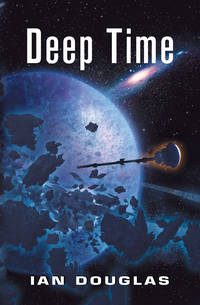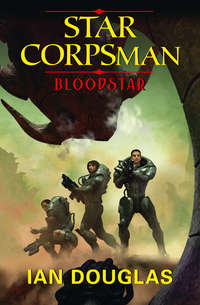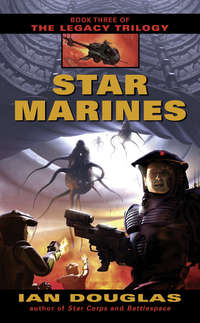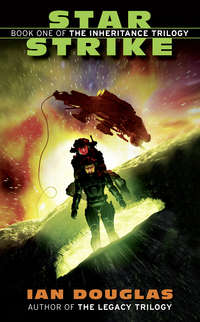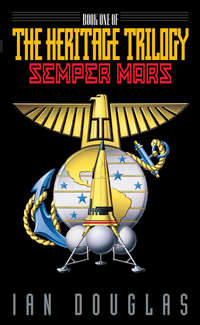
Полная версия
Abyss Deep

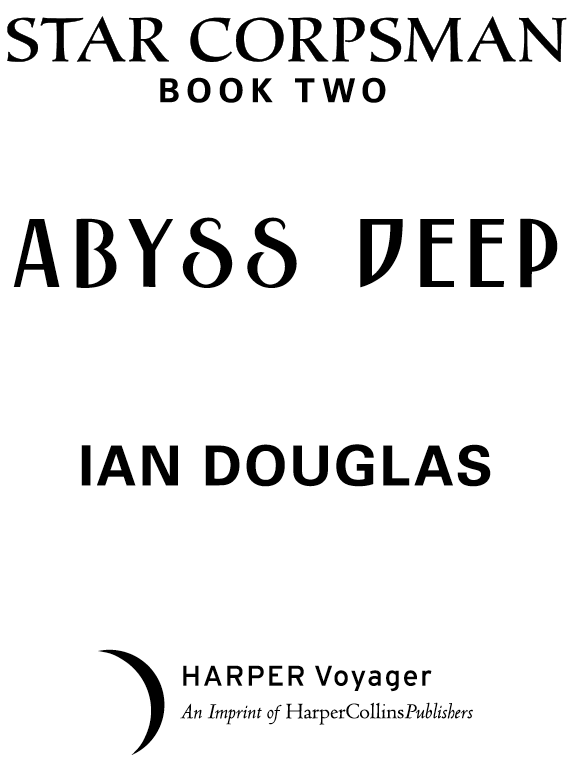
Dedication
For Dave Plottel, who first introduced me to the wonders of Godel numbers many years ago …
and, as always, to my beloved Brea.
Contents
Dedication
Armor up!
Chapter One
Chapter Two
Chapter Three
Chapter Four
Chapter Five
Chapter Six
Chapter Seven
Chapter Eight
Chapter Nine
Chapter Ten
Chapter Eleven
Chapter Twelve
Chapter Thirteen
Chapter Fourteen
Chapter Fifteen
Chapter Sixteen
Chapter Seventeen
Chapter Eighteen
Chapter Nineteen
Chapter Twenty
Chapter Twenty-One
Chapter Twenty-Two
Chapter Twenty-Three
Chapter Twenty-Four
Star Corpsman
Epilogue
About the Author
By Ian Douglas
Copyright
About the Publisher
“Armor up!”
I squeezed into a waiting Mark 10 hanging on the rack, sealed it off, and accepted a helmet from Thomason. “Thanks, Staff Sergeant,” I told him. “What’s going down?”
“Some of our people are on the ice,” he said. “Trapped … by one of those things.”
Wiseman handed me a Mk. 30 carbine. I checked the safety, wondering if a half-megajoule laser pulse would even register in a cuttlewhale’s consciousness. I might have better luck throwing snowballs at the things.
“Open the hatch!” Hancock called. The dim red-dish light of Abyssworld spilled into the lock as the ramp lowered in front of us.
Haldane had touched down on the ice perhaps a kilometer away from the spot where the cuttlewhale had lunged up through the ice. Thirty Marines and two Corpsmen were out here, converging on the ship as quickly as possible. I could see several of them using their meta-thrusters to make low, bounding leaps across the pressure ridges, their combat-armor nanoflage making them almost invisible in the dim light. In the distance, the snaky silhouette of a cuttlewhale weaved against the swollen red face of the sun.
“Perimeter defense!” Hancock called. “Dalton! Set up your weapon to put fire on that thing!”
We spread out, creating a broad circle around the grounded Haldane. Visibility sucked. The wind from the west had picked up, and we were staring into a layer of blowing ice crystals and freezing fog perhaps two meters deep. I dropped to the ice alongside Bob Dalton, helping him unship his M4-A2 plasma weapon.
Chapter One
There’s an old, old expression in the military, one that can probably be traced back to some platoon sergeant in the army of Sargon the Great: hurry up and wait.
In fact, it’s been said that 99 percent of military life ranges from tedium to unbearable boredom, with the remaining 1 percent consisting of stark, abject terror. A lot of that tedium comes with the waiting … especially if what you’re waiting for is that few moments of crisp, cold terror.
“Doc Carlyle!” the gunnery sergeant’s voice called on my private channel. “You okay?”
“Yeah, Gunny. No problems.”
“Remember to breathe, okay?”
I swallowed, trying to center myself into a calm acceptance of whatever was to be. “Aye, aye, Gunnery Sergeant.” As the platoon’s Corpsman, I was supposed to be monitoring all of the Marines inside the tin can … but Gunnery Sergeant Hancock had been watching my readouts, and noted the increase in pulse and the unevenness of my respiration.
I was packed in with the forty-one Marines of 2nd Platoon, Bravo Company, inside the cargo deck of a shotgun Katy. That’s the Marines’ name for the KT-54 orbital cargo transporter, a big, chunky tug with meta-thrusters on one end and a blunt-ended cylinder on the other. We were in full armor—a KT’s cargo can isn’t pressurized—strapped upright to ranks of backboards … and waiting. They hadn’t opened the can yet, so we were in near total darkness. A maddeningly calm voice inside my head, an extremely sexy woman’s voice, said, “Five mikes.”
“Ah, copy that,” another voice said. “Crack ’er open and let’s see what we got.”
In front of me, beyond the lined-up helmet backs of nine Marines, the end cap of the Katy split in two and began to swing open. If we’d been riding in the throat of an alligator, that’s what we would have seen when he yawned. Light blasted in from a slender horizon to my right, silhouetting the closely packed Marines and illuminating the utilitarian interior of the can.
“Four minutes. Brace for course correction in three … two … one … fire.”
I felt a short, sharp kick along my back. The Katy’s AI pilot had just fired the engines, giving us a slight bump up in velocity and making a micro correction to our course. I wondered if the bad guys at Capricorn Zeta had noted the course change, and were getting ready to welcome us.
“Okay, platoon.” That was our platoon CO, Second Lieutenant Paul Singer. “Unship your harnesses.”
I used a thoughtclick to unsnap the harness holding me against the rigid backboard. God knows we didn’t have room in there to fumble with snaps and fasteners with our gauntleted hands. I glanced up and felt claustrophobic. The Marines of 2nd Platoon were lined up on the canister’s bulkheads in four ranks of ten each, plus two extras—Singer and Staff Sergeant Thomason. The helmets of three of them were less than a meter from my own, coming in from either side and one seemingly suspended head-down directly above me.
There is no “up” or “down” in zero-G, of course. From Corporal Gobel’s vantage point, I was the one hanging upside down.
“Three minutes.” Damn, but that AI’s voice sounded sexy. “Two hundred kilometers.”
The seconds trickled away as we continued waiting in ranks. Two hundred kilometers to the target was a long way, too far for us to see the objective yet. But it was out there, probably well above the gleaming curve of the Earth. Then I noticed a bright star directly ahead, and queried my in-head. Was that the objective? The platoon AI responded by putting a red box around the star, together with a fast dwindling set of numerals just to one side. Approaching in a lower, higher-speed orbit, we were closing with the target at just over two kilometers per second. According to the opplan, the shotgun would fire when we were ten kilometers from our objective.
“Okay, Marines,” Lieutenant Singer said, “Listen up. We do this by the book, and we’ll come through this alive.”
Well, most of us, I thought. Maybe …
If we were very, very lucky… .
“Remember to steer for the rock end of the facility,” Singer went on. “The doughnut will navigate itself to the main control hab, and that’s where we’ll make the breach. We don’t know what kind of defenses the tangos might have in there, so stay sharp, and keep an eye on your CT2 displays. Got it?”
“Ooh-rah!” a number of the Marines chorused back, their centuries-old battle cry.
I wondered how the CT2W could sort new fear from what was there already.
Oh, I knew how it worked in theory. The Cognitive Technology Threat Warning System has been around in one form or another since the early twenty-first century. It picks up P300 brainwaves, which are linked to stimulus evaluation and categorization. Back in the 2020s, this was handled by a smart helmet equipped with scalp sensors. For the last century or so, though, it’s been a program running within a soldier’s cerebral implants. The idea is that we can detect a threat subconsciously, well before it actually manifests as a bad guy with a weapon. It sounds wild, using brainwaves to detect subconsciously perceived threats, but tests show Marines pick up about 47 percent of hidden threats with just their eyes or standard optics … compared with 90-plus percent when they’re running a CT2WS.
“Two minutes.”
“Weapons check,” Staff Sergeant Thomason called. “Lock and load!”
I looked at my own weapon, a Mk. 30 Sunbeam-Sony carbine packing a half-megajoule-pulse in a mass of just four kilos. My sidearm was the usual Browning Five, a stubby, mag-accelerator handgun that could hurl a five-millimeter bit of steel-jacketed depleted uranium at a thousand meters per second. Both weapons were charged, hot-linked to my in-head, and safed.
There’s an old myth that says Navy Hospital Corpsmen don’t go into combat armed. That might have been true once, back when the Geneva Convention dictated the rules for civilized warfare. Unfortunately, any nonhuman bad guys we happened to run into weren’t going to be signatories of those documents … and that was definitely true of the human hijackers we were facing now.
“Hey, Gunny,” Sergeant Woznowiec called. “Any intel yet on how many tangos are waiting for us in there?”
“Negative on that, Woz,” Hancock replied. “When I know, you’ll know.”
“Comm silence,” Singer warned. “Stay the hell off the TC.”
Shit. The tactical channel was shielded and short-ranged. There was no way the bad guys could be listening in. Singer was an asshole … worse, a wannabe asshole fresh out of the Naval Academy.
“One minute.”
“We’re getting a warn-off from Zeta station,” Thomason said. “They’ve seen us.”
There was a lot of traffic in low-Earth orbit. The idea had been to slip in close like an innocent cargo tug. Unfortunately, that deception couldn’t provide us with cover indefinitely. The station’s radar would have been tracking us for long minutes already, and collision avoidance alarms might be going off over there already.
“Twenty seconds,” Thomason added. “Dropping the backrests.”
Those rigid boards behind our backs, shaped to fit our armor backpacks and meta tanks with snug precision, were grown from the canister’s internal nanomatrix, just like made-to-order chairs and tables grown from the floor. At an electronic command from our AI, they dissolved back into the deck, leaving each of us moving with the Katy. I felt my boots leaving the deck, just by a few millimeters, as the sexy AI voice sounded off the final countdown.
“Cargo launch in five … four … three … two … one … initiate.”
The Katy fired its forward maneuvering thrusters. From our point of view, the walls of the cargo canister abruptly slid backward, and the entire platoon emerged suddenly into open, empty space. The vast, eye-watering blue and mottled white of Earth filled half of the sky with aching beauty. The sun was squarely at our backs; the sunset terminator stretched along the curve of the horizon ahead.
The Marine version of a KT-54 was called a shotgun Katy for a reason. By decelerating sharply, the vessel’s armored human cargo hurtled from the wide-open bow, moving at the same speed as the tug until it slowed. Now it was dropping away behind us, empty, and 2nd Platoon kept moving at a constant velocity toward our objective. For all intents and purposes, it was as though we’d just been fired into space like a cloud of pellets from an enormous shotgun.
“Platoon, shift to Formation One,” Singer ordered. “Deploy!”
Our Mk. 10 suits were locked into standard M287 dorsal jumpjet packs. On the ground they let us bound across the landscape in twenty-meter jumps. In open space, they turned each of us, in effect, into a small, independent spacecraft. They were fueled by cryo-stabilized N-He64, an exotic fuel commonly called meta that was far denser in terms of available energy than conventional propellants. The thrusters were controlled by our in-head software; I told mine that I wanted to move into Formation One, and my backpack gave a gentle kick to my right.
The Marine formation was opening up, creating a more dispersed target in case the bad guys started taking shots at us. The shift also cleared the way for our doughnut, which was accelerating now on its own, moving up the center of the formation and into the distance ahead, homing on the bright star of Capricorn Zeta.
My jumpjet pack bumped again, halting my outward drift. Around me, the Marines appeared to be unmoving, hanging motionless in space relative to me and to one another. The surface of the Earth, however, drifted past at a steady pace. We were coming up on the west coast of Baja at the moment; north, I saw the cloudless ocher expanses of the Arizona and New Mexico deserts; southeast, bright stars strung in a vertical line stretching up into the sky flashed with a steady wink-wink-wink that marked the space elevator over Cayambe, a thread otherwise made invisible by distance.
And moment by moment, the Zeta facility grew brighter, taking on shape and form—an awkward collection of cylinders dazzling in the sunlight, connected at one end to a black rock a kilometer across.
We’d been thoroughly briefed on the Zeta situation, of course, complete with in-head downloads showing every detail of the five-hundred-meter facility. Asteroid mining was a particular target of the neo-Ludd movement, of course, so Zeta had offered them some highly visible propaganda for the watching global netizens back on Earth.
That small and wrinkled-looking nickel-iron asteroid, listed as Atun 3840, was only a kilometer across, but it contained an estimated 2 trillion dollars’ worth of platinum, 2 trillion in iron and nickel, and perhaps 1.5 trillion dollars’ worth of cobalt … a total of more than 5 trillion dollars of commercial metals.
The first asteroid mining had commenced early in the twenty-first century, with robots that extracted precious metals on-site and slingshotted them back to circum-Earth space where they were captured. There, one-ton slugs of solar-purified metal were injected with inert gas, molded into lightweight glider wings, sheathed in cheap, refractory heat shielding, and sent on down for recovery in the ocean … a cheap and highly efficient system still used to this day. The very first of Humankind’s trillionaires made their fortunes with the various space mining start-ups of the 2020s, paid for our expansion out into the Solar System, helped us survive the return of the Ice Age, and ultimately funded the first starships.
Later, it proved more cost effective to nudge target asteroids out of their original orbits and swing them into Earth orbit. Decelerating one large mass, it turned out, was a lot easier than trying it with millions … and safer as well. That fact was abundantly demonstrated when the catchers missed a slug of iridium in 2094 and it slammed into the Lunar farside.
For a century and a half, now, more or less, we’ve been bringing whole asteroids into Earth orbit and dismantling them there, using a couple of close Lunar passes to decelerate them. The AIs managing their vectors are good … and the meta-thrusters used for precision adjustments are reliable enough that even if something—unthinkable!—goes wrong, they can sling the rock into a higher and safer orbit. Hell, they have to be good just to shift the orbit periodically to avoid cutting the space elevator.
But the neo-Ludds are less accepting of the claims and promises of technology. They’re probably best known for their opposition to cerebral implants and the global Net, but orbital mining is a popular target too. This time, they’d made it a literal target by boarding Capricorn Zeta and threatening to drop Atun 3840 on Earth.
The rock wasn’t a dinosaur-killer, but it would make a hell of a mess if it hit. An ocean strike meant tidal scouring continents for hundreds of kilometers inland; a land strike could annihilate a dozen cities and raise a global dust cloud that would wreck our ongoing attempts to beat back the new ice age, and might even knock us all the way into a “Snowball Earth” scenario. These guys were nuts.
And so the president had given the order: the Marines would take back Capricorn Zeta. Negotiations had been going on for a week already, but had been going nowhere. And then a few hours ago a hostage had been shoved out an airlock. The terrorists’ key and nonnegotiable demand—that humans abandon space industrialization—simply wasn’t going to happen.
The kicker was that there were still fifty-four people on board Capricorn Zeta, not counting an estimated twenty tangos. There reportedly also were two M’nangat on board … and that made it an interstellar incident. Our orders were distressingly precise. Our first priority was to secure Atun 3840—which meant capturing the facility’s meta-thruster controls. Second was to make certain the two visiting M’nangat were safe. Saving the miners and corporate officials in the facility came in only at number three.
My tactical in-head showed the doughnut was almost there. A steady countdown was silently running against my field of view. We were twenty seconds now from touching down.
Thirty meters away, Lance Corporal Stalzar’s armor lit up, a dazzling flare of light consuming the torso of his suit. We all heard the shriek …
“Sniper!” Thomason called. “Marine down!”
I was already checking Stalzar’s readouts on my in-head. There was nothing … nothing I could do… .
A second star appeared close to the asteroid’s horizon, opposite the mining station, growing brilliant, then fading. We had countersnipers both up on Geosynch Center, halfway up the space elevator, and on board a Marine transport a few thousand kilometers above and behind us. They’d seen the pulse of the tango’s laser when he’d shot Stalzar, and vaporized the chunk of asteroid terrain where he’d been hiding.
Ten seconds. What had been a bright star, then a gleaming toy in the sunlight, was expanding now into something much larger. Another silent flare of light on the asteroid marked a second countersniper shot. Maybe they’d spotted a tango’s heat signature against the rock.
Five seconds. The rock drifted off to my right. Directly ahead, the silvery smooth surface of the mining facility’s Hab One now filled my forward view. I could see the alphanumerics painted on the hull, and a corporate logo—Skye Metals—sandblasted by orbiting grit. The doughnut was affixed to the hull high and a little to my left. I shifted my vector slightly, aiming for a flat surface nearby. I gave an in-head order, and my AI flipped me end-for-end. My feet were aimed at the station as my thrusters cut in, slowing me. I hit the hull two seconds later, flexing my knees to absorb the impact. Around me, Marines were raining out of the sky, touching down on the hull, then moving toward the doughnut.
I let the Marines go first, of course. As the platoon’s Corpsman—the “Doc”—I was expected to keep up but not to engage in combat. That was the contract U.S. Navy Corpsmen had shared with the Marine Corp for the past three centuries or so: they do the fighting, and we patch ’em up.
The waiting was over. The first Marine fireteam was plunging into the doughnut, headfirst.
The VBSS Mobile Nano-utility Lock is indispensible for Visit Board Search and Seizure ops in hard vacuum, especially when the visit is being resisted by an armed enemy. It really is a doughnut wheel some three meters across, with what looks like a black sheet stretched taut across the hole. It hits the hull of a target vessel or base, and nanodisassemblers on the business side chew through metal, plastic, and active nano sheathing with ease. The black sheet is a nanomatrix pressure shield just a few molecules thick; it holds in the target vessel’s air, but molds close to a boarder’s armor, letting him pass through without venting atmosphere.
“Rogers! Jorgenson!” Thomason snapped over the platoon channel. “Hold up!”
The next two Marines in line waited, clinging to handholds on the doughnut. Thomason was watching what was happening inside by means of cameras mounted on the helmets of the first four-man fireteam.
“Okay!” Thomason said. “Fireteam two! Go!”
Rogers and Jorgenson slipped through the lock, followed by Beaudet and Tomacek. They were followed by the next fireteam … and the next. I wasn’t tapped in to the visual channels, but I could hear the radio calls of the Marines already inside.
“Watch it! Watch it! Tango at oh-one-five!”
“Moving! Firing!”
“Rogers! Morrisey! To your right!”
“Got him! Tango down!”
“Sobiesky! You and Marshall secure the hatch! The rest of you, with me!”
More and more of the platoon’s Marines vanished through the doughnut, until it was my turn. I grabbed the handholds and pulled myself forward. I could feel the nanoseal closing around me, clinging to me, sliding down my torso as I moved … and then I was through.
The interior was a large compartment some ten meters across, dark except for emergency lights spaced around the bulkheads. Directly ahead, my helmet light illuminated a massive tangle of pipes and conduits—the business end of the nano-D mining equipment eating its way into the heart of Atun 3840. A dead tango floated in the air nearby, wearing what looked like a Chinese space suit without the helmet. A MAW drifted nearby.
Magnetic accelerator weapons aren’t a real good choice for close combat inside a pressurized environment. I wondered how well trained these idiots were.
A Marine fireteam on the far end of the hab module used an applicator gun to smear a two-meter circle of nano-D against the bulkhead, and then one of them gave the smoking ring a hard kick. Gunfire cracked and clanged as magnetic rounds snapped through the opening and punched through bulkheads, a cacophony of noise after the silence of our passage through vacuum. Corporal Tom Morrisey screamed, and I saw a flash of incoming data on my med channel.
“Corpsman!” Thomason yelled. “Marine down!”
I was also getting environmental warnings, and a station Klaxon began sounding an alert. Some of the rounds that had missed Morrisey had punched through the facility’s outer hull. The station’s external nanomatrix would seal the holes, but that would take a few moments, and the air pressure was dropping precipitously in the meantime.
That wouldn’t hurt us, of course, but it put the station’s crew in danger.
I kicked off the bulkhead and glided across the compartment to Morrisey. His right arm was missing below the elbow, the armor there was a tangled mess, and blood was spurting from the wreckage in a bright orange-red arterial stream that was breaking off into darker gobbets as it spiraled with his rotation. I collided with him and stabilized his spin, then jacked into his armor for a direct readout.
The magnetically accelerated slug had sliced through his elbow with kinetic energy enough to shred armor and amputate the lower arm. Normally, Marine armor will guillotine shut above a serious leg or arm wound, stopping the bleeding and, more important, stopping the suit from venting its air into vacuum. That last might be a problem in another few minutes, but right now the cabin pressure was high enough that the armor’s slice-and-seal function hadn’t triggered. Morrisey’s brachial artery was pumping out blood fast; he would be dead in a few minutes if I didn’t stop the bleeding.
I did a quick scan to make certain he didn’t have any head trauma—it looked like it was just his arm that had been hit, but you never know—then thoughtclicked a key directing Morrisey’s suit to autoinject a jolt of anodynic recep blockers into his carotid artery. Heart rate 155 … BP 149 over 90, respiration 36 and gasping, rapidly elevating levels of both adrenalin and noradrenalin.
Morrisey stopped screaming as the nanoanadynes started shutting down the doloric receptors in his thalamus and the insular cortex, blocking the pain signals as they reached his brain. “Jesus, Doc!” he said. “I can still feel it! It feels … weird!”




